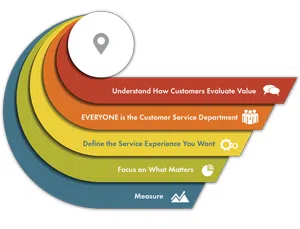Five Steps to get the most out of your customer service department
Customer service is a term that is often used casually to describe a process for managing customer complaints or measuring customer satisfaction. Although there is nothing inherently wrong with this perspective, it puts limits on the role that customer service plays within an organization and therefore limits the impact it can have in differentiating through the customer experience.
For your purposes, let’s define customer service more broadly so that it includes the overall service experience you’d like to deliver. On that basis, you can define customer service as the advice, support, problem solving and other activities that, along with the product or service, fulfills the promise that was purchased.
Using this definition, customer service plays a major role in creating the experience the customer enjoys (or not) when doing business with us. Here are five steps you can take to make customer service work as the engine of growth and profitability.
Understand How Customers Evaluate Value
For the most part, service quality is intangible. The quality of the repair or the thoroughness of the maintenance activity cannot readily be seen. It will be a rare day where the customer goes up on the roof with your technician to observe the careful attention that he or she pays to the roof top unit to ensure there will be no unexpected failures during those hot days of summer.
They certainly cannot see inside your technician’s head as she analyzes the situation and uses her expertise to recognize the true cause of the failure. How does the customer know the hour of troubleshooting was remarkably short or unnecessarily long?
The short answer is, they can’t readily make that assessment. So how does the customer judge the quality of the service or the excellence in troubleshooting? They judge this by how the service is delivered; and how the service is delivered is your definition of customer service.
Therefore, customer service becomes a critical part of service delivery and the service experience. Customer service directly reflects on the quality of the work. Poor customer service suggests poor quality and so, not only does the customer have a negative experience, it directly impacts their perception of the quality of the actual service itself.
By understanding the integral role customer service plays in service quality assessment and the overall service experience, you can focus on customer service to differentiate your organizations and help it work for us. It also helps you recognize that good customer service involves everyone.
EVERYONE is the Customer Service Department
Since customer service is an integral part of the overall service delivery, it’s critical that everyone recognizes their role in delivering it.
That means that how quickly and how friendly the phone is answered, how often and how well the customer is kept informed, how timely and how accurately invoices are processed and even how courteously and how safely your technicians drive their vehicles are all as important in communicating value as the work itself.
No one and nothing can be exempt from being part of the customer service department.
Delivering exceptional customer service also means managing the customer’s expectations. Salespeople can’t over promise. Marketing cannot misrepresent. The customer must understand what they can expect and you must deliver on the expectation consistently across the entire organization.
Define the Service Experience You Want
Getting everyone to recognize that they’re the customer service department is a critical step but of little value unless they know what they must do to deliver an exceptional customer experience.
If you want customer service to work for you, your job is to define what that experience will be and how it will be delivered. Fortunately, there are some tools that you can use to help. One is called the RATER model.
In 1990, professors from Texas A&M University identified the dimensions of exceptional customer service in their book “Delivering Quality Service.” They found that there were critical dimensions that defined service quality, and from their work emerged a customer service model called RATER, which focused on five.
Their research indicated that a service firm that can deliver on all five dimensions contained in the model can create an exceptional service experience. The name RATER is an acronym with each letter representing the first letter of one of the five dimensions. They are:
• Reliability: Your ability to dependably and accurately deliver as promised.
• Assurance: Your ability to convey trust and confidence.
• Tangibles: Your personal presentation and the condition of the physical facilities and equipment.
• Empathy: Your ability to demonstrate a high degree of caring and individual attention.
• Responsiveness: Your willingness to promptly and courteously respond to customers’ needs.
This simple, yet practical model provides you with the framework you need to define the service experience you’d like to create and to translate that definition into specific actions to be taken by every employee to deliver on it.
Focus on What Matters
I work with a dynamic organization that has an unrelenting focus on customer service. Every action they take, whether a new service delivery or the shape and content of a new form, is measured against how it will impact their ability to deliver on their promise to their customers.
By vetting every action through this filter, they focus on what matters most — delivering an exceptional customer service consistently over time. It also helps them to maintain their attention on continuous improvement.
If you want to ensure that customer service works for your company, you need to persistently pay attention to it. How does this action or this process impact on your ability to deliver on your promise? Will it help or hinder you? How will the customer experience it?
Measure
What gets measured gets managed. Although there may be some debate on who originally coined this phrase, there is little debate about the truth behind it. If you want your customer service to work for you, you must measure to see how well you’re progressing against your goals. Failure to do so would be like sailing alone around the world without a compass or a sextant — you might make progress, but you’ll never know it.
Measurement also depends on knowing what to measure and the ultimate target. Without knowing where you’re going, it’s impossible to judge whether you’ve achieved your goal.
Once you know what your goals are, the question then comes down to what to measure. Customer satisfaction and customer loyalty immediately come to mind. If you’re on the right track with your customer service, then you should see high scores for both.
One good measure of this is called Net Promoter Score. It’s a single question to measure customer loyalty and intention and, over time, will uncover trends that will be helpful for managing your business.
Customer satisfaction surveys, while helpful, are not the only way to measure progress in customer service. In-depth, one-on-one interviews with selected customers or interviewing a group of customers in a focus-group type setting will provide excellent feedback on those aspects of your customer service not easily measured by survey questions.
Operational metrics will also be good indicators of how effectively you are delivering on your defined customer service experience.
Customer service is more than just a measurement of customer satisfaction scores and responding to complaints to resolve issues after the fact. It is an integral part of the overall service delivery that helps the customer evaluate the quality of the service they received. To make customer service work for you, it’s critical that you’re clear about what is to be delivered and everyone understands what they need to do to deliver on that promise.






